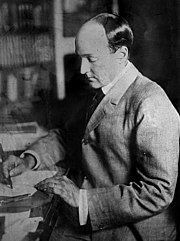Stewart Edward White
| Stewart Edward White | |
|---|---|

Stewart Edward White, 1912
|
|
| Born |
March 12, 1873 Grand Rapids, Michigan, United States |
| Died | September 18, 1946 (aged 73) Hillsborough, California |
| Occupation | Author |
| Nationality | American |
| Alma mater | University of Michigan |
| Period | 1901 to 1940 |
| Genre | Paranormal, adventure, travel |
| Literary movement | New Age |
| Notable works | The Unobstructed Universe |
Stewart Edward White (12 March 1873 – September 18, 1946) was an American writer, novelist, and spiritualist. He was a brother of noted mural painter Gilbert White.
Born in Grand Rapids, Michigan, he attended Grand Rapids High School, and earned degrees from University of Michigan (B.A., 1895; M.A., 1903).
From about 1900 until about 1922 he wrote fiction and non-fiction about adventure and travel, with an emphasis on natural history and outdoor living. Starting in 1922 he and his wife Elizabeth "Betty" Grant White wrote numerous books they say were received through channelling with spirits. They also wrote of their travels around the state of California. White died in Hillsborough, California.
Whenever you see a dust through the trees, you look first to make sure it is not raised by stray cattle. Then when you are certain of your horse and man, you start a fire in the little stove. That is the invariable rule in the mountains. The logic is simple, unanswerable, and correct. The presence of the man argues that he has ridden from some distant point, for here all points are more or less distant; and the fact in turn proves that somewhat of exercise and space have intervened last he has eaten. Therefore, no matter what the time of day, you feed him. It works out like a mathematical formula.
White's books were popular at a time when America was losing its vanishing wilderness. He was a keen observer of the beauties of nature and human nature, yet could render them in a plain-spoken style. Based on his own experience, whether writing camping journals or Westerns, he included pithy and fun details about cabin-building, canoeing, logging, gold-hunting, and guns and fishing and hunting. He also interviewed people who had been involved in the fur trade, the California gold rush and other pioneers which provided him with details that give his novels verisimilitude. He salted in humor and sympathy for colorful characters such as canny Indian guides and "greenhorn" campers who carried too much gear. White also illustrated some of his books with his own photographs, while some of his other books, were illustrated by artists, such as the American Western painter Fernand Lungren for "The Mountains" and "Camp and Trail". Theodore Roosevelt wrote that White was "the best man with both pistol and rifle who ever shot" at Roosevelt's rifle range at Sagamore Hill.
...
Wikipedia
